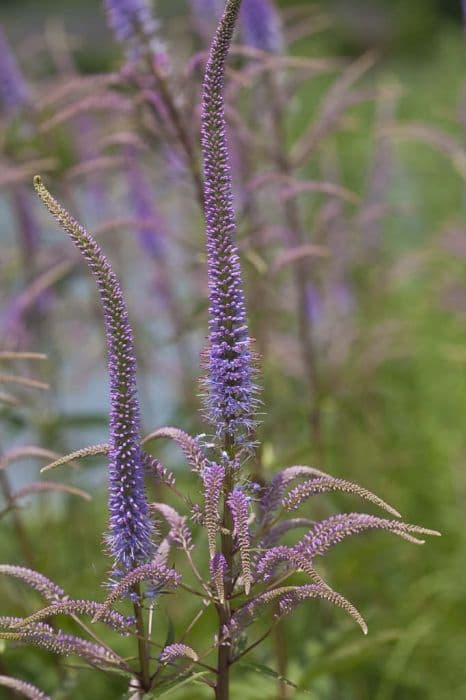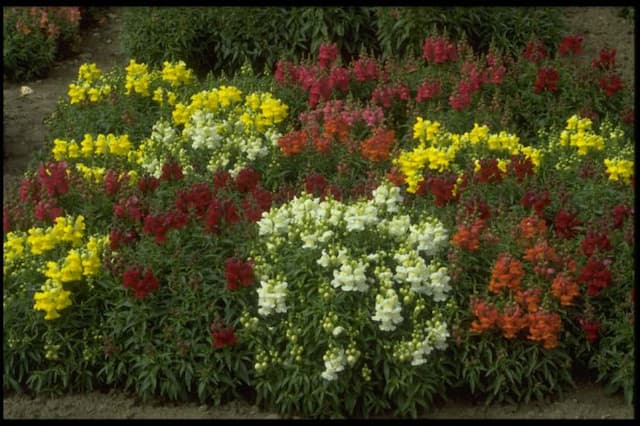Culver's root Veronicastrum virginicum 'Fascination'

ABOUT
The Veronicastrum virginicum 'Fascination', commonly known as Culver's root, is a perennial plant that boasts striking features. This cultivar is known for its tall, elegant spires of small, tubular flowers that bloom in a lovely array of lilac to soft violet shades. The flowers are densely packed, forming a candelabra-like arrangement atop sturdy, upright stems which add a sense of vertical drama to garden spaces. The foliage of Culver's root 'Fascination' adds to its beauty, with whorls of narrow, lance-shaped leaves that encircle the stems at intervals, creating a ladder-like appearance. These leaves are often deep green, providing a lush backdrop for the delicate flowers. The overall effect of the plant is one of grace and structured beauty, making it a favorite among gardeners who seek to add a touch of elegance to their plantings. The flowering period of Culver's root 'Fascination' occurs in the summer, and it tends to attract various pollinators, including bees and butterflies, which adds an extra layer of liveliness to its presence. It is often planted in perennial borders, wildflower gardens, or naturalized areas where its vertical lines and distinctive blooms can be fully appreciated.
About this plant
 Names
NamesFamily
Plantaginaceae
Synonyms
Culver's Root, Culver's Physic, Bowman's Root, Black Root, Tall Speedwell, Veronicastrum
Common names
Leptandra virginica, Veronica virginica, Paederota virginica.
 Toxicity
ToxicityTo humans
Culver's root is not commonly known to be toxic to humans. There's a lack of substantial evidence indicating that ingestion of this plant causes poisoning. However, like any plant not intended for consumption, it's generally recommended to avoid eating it as it may cause gastrointestinal discomfort or an allergic reaction in some individuals.
To pets
Culver's root is not widely recognized as a toxic plant to pets either. It does not typically appear on lists of plants that are hazardous to dogs, cats, or other domestic animals. Ingestion may result in mild stomach upset, but there is no well-documented case of severe poisoning in pets from this plant. However, as with any non-food plant, it is advisable to prevent pets from consuming it to avoid the possibility of any adverse effects.
 Characteristics
CharacteristicsLife cycle
Perennials
Foliage type
Deciduous
Color of leaves
Green
Flower color
Lavender
Height
4-7 feet (1.2-2.1 meters)
Spread
2-4 feet (0.6-1.2 meters)
Plant type
Herb
Hardiness zones
3-8
Native area
North America
Benefits
 General Benefits
General Benefits- Attracts Pollinators: Culver's root 'Fascination' provides nectar and pollen for bees and other beneficial insects.
- Visual Appeal: Its tall, elegant spires of lavender to pinkish flowers add vertical interest to garden beds and borders.
- Drought Tolerant: Once established, Culver's root 'Fascination' is relatively tolerant of dry conditions, requiring minimal watering.
- Low Maintenance: This perennial plant requires little care once established, making it suitable for low-maintenance landscapes.
- Naturalizes Easily: Culver's root 'Fascination' can spread and naturalize over time, creating larger swathes of color in the garden.
- Wildlife Habitat: Provides shelter and breeding spots for wildlife, particularly when planted en masse.
- Seasonal Interest: Flowers in the mid to late summer, providing interest during a time when many other plants may have finished blooming.
- Easy to Grow: Culver's root 'Fascination' is generally easy to cultivate in a variety of soil types and climates.
- Improves Soil Health: Its root system can help prevent soil erosion and improve soil structure over time.
- Companion Planting: Works well when planted alongside other perennials and grasses, offering a complementary structure and color palette.
 Medical Properties
Medical PropertiesThis plant is not used for medical purposes.
 Air-purifying Qualities
Air-purifying QualitiesThis plant is not specifically known for air purifying qualities.
 Other Uses
Other Uses- Culinary Garnish: The spikes of Veronicastrum virginicum 'Fascination', also known as Culver's root, can be used as a decorative element in gourmet cuisine, though typically they are not consumed.
- Natural Dyes: The root and sometimes the leaves can be used to extract natural dyes for textile coloring, providing a range of subtle hues.
- Educational Tool: In gardening classes or workshops, Culver's root can be used to demonstrate plant structure and pollinator attraction strategies to students and amateur gardeners.
- Ink Production: Historically, some root-based plants have been utilized to make inks, and the roots of Veronicastrum virginicum might also have potential for this use, though it's a less common application.
- Photography Prop: Due to their striking appearance, the tall spires of flowers can be used in floral photography to add height and interest to compositions.
- Floral Arrangements: While not unusual, the plant's linear form and elegant flowers make it ideal for inclusion in contemporary floral designs and bouquets.
- Garden Structure: The tall, upright growth habit of Veronicastrum virginicum can be used to provide vertical structure in garden beds and borders.
- Biomimicry Inspiration: The structural form of Culver's root could inspire designs in the field of biomimicry, influencing patterns or shapes in architecture or engineering.
- Crafting Materials: Dried stems of Veronicastrum virginicum can be used in making crafts, such as in basketry or as a natural element in homemade papermaking.
- Environmental Studies: The plant can be an interesting subject for environmental and ecological studies, regarding its role and attractiveness to native pollinators and its adaptation to local soils and climates.
Interesting Facts
 Feng Shui
Feng ShuiThe Culver's root is not used in Feng Shui practice.
 Zodiac Sign Compitability
Zodiac Sign CompitabilityThe Culver's root is not used in astrology practice.
 Plant Symbolism
Plant Symbolism- Healing: Veronicastrum virginicum, commonly known as Culver's root, is often associated with healing due to its medicinal properties that were used by Native Americans.
- Purity: The flower's spike-like appearance and the color white, common in some varieties, symbolize purity and innocence.
- Serenity: The soft, vertical lines of Culver's root could be seen as bringing calmness and serenity to a garden, symbolizing peace and tranquility.
- Connection with nature: As a native plant to North America, Culver's root is often used in naturalistic plantings, symbolizing a strong connection with the natural world.
 Water
WaterCulver's root should be watered thoroughly once a week, providing approximately 1 inch of water each time. During periods of drought or extreme heat, watering frequency may need to increase to twice per week. It is best to water the plant early in the morning to allow leaves to dry out during the day, reducing the risk of fungal diseases. Be sure to water at the base of the plant to avoid wetting the foliage unnecessarily. Overhead watering should be avoided to maintain healthy foliage and flowers.
 Light
LightCulver's root thrives best in full sun to partial shade. The ideal spot for this plant would receive sunlight for at least 6 hours a day, though it can tolerate some shade, especially in the afternoon. Avoid deep shade as it may result in weak growth and fewer blooms.
 Temperature
TemperatureCulver's root can withstand a wide range of temperatures, however, it grows best when the daytime temperatures are between 68°F and 75°F. It can endure minimum temperatures down to about -20°F, making it suitable for gardeners in colder regions. The plant is hardy and adapts to the usual fluctuating temperatures of temperate climates without any special requirements.
 Pruning
PruningCulver's root should be pruned to remove spent flowers, which encourages a second bloom and maintains the plant's appearance. Pruning is best done shortly after the first flowering is over, typically in mid to late summer. Cutting the plant back in late winter or early spring prepares it for the growing season by removing any dead or damaged growth.
 Cleaning
CleaningAs needed
 Soil
SoilCulver's root 'Fascination' thrives best in a well-draining soil rich in organic matter with a pH range of 5.8 to 6.8. A mix of garden soil, compost, and perlite or coarse sand can create an ideal environment for this plant. Ensure that the soil retains some moisture but is not waterlogged.
 Repotting
RepottingCulver's root 'Fascination' typically does not require frequent repotting and can be repotted every 2-3 years or when it becomes root-bound. Spring is the best time for repotting to encourage growth in the growing season.
 Humidity & Misting
Humidity & MistingCulver's root 'Fascination' is tolerant of a range of humidity levels and can usually adapt to the ambient outdoor humidity in its growing region. It does not require any specific humidity adjustments when grown in garden settings.
 Suitable locations
Suitable locationsIndoor
Provide bright light and well-draining soil for Culver's root inside.
Outdoor
Plant in rich soil, full sun to partial shade for outdoor Culver's root.
Hardiness zone
3-8 USDA
 Life cycle
Life cycleCulver's root 'Fascination' (Veronicastrum virginicum 'Fascination') begins its life as a seed, which, when sown in a suitable environment, germinates and develops into a seedling. The seedling phase is followed by vegetative growth where the plant forms a rosette of leaves at ground level. As the plant matures, it elongates and develops a tall, upright stem with whorled leaves, reaching its full height of up to 4-7 feet. Once mature, typically in midsummer, it produces long, elegant spires of tiny, tubular, lilac-purple flowers that are highly attractive to pollinators. After pollination, the flowers develop into small, dry fruits (capsules), which contain the seeds for the next generation. Culver's root 'Fascination' completes its life cycle when it dies back to the ground following the first frost, but it can re-emerge from the root system in the following spring.
 Propogation
PropogationPropogation time
Late Summer to Early Fall
Culver's root, scientifically known as Veronicastrum virginicum 'Fascination', can be propagated most effectively through division in the early spring or fall. To propagate by division, carefully dig up an established clump of Culver's root and use a sharp spade or knife to divide the root ball into smaller sections, ensuring that each section has at least one growth point or shoot. These divisions can then be replanted into prepared soil, spaced approximately 18 to 24 inches (45 to 60 cm) apart to allow ample space for growth. Water the new divisions thoroughly after planting to help establish them. This method is popular because it maintains the genetic consistency of the plant and allows for a quicker establishment in the garden compared to seed propagation.



![Foxglove [Illumination Ruby Slippers]](/_next/image?url=https%3A%2F%2Fplants-admin.emdemapps.com%2Fimages%2Fplants%2F%2Fimages%2F604b5cbc93f0b.png&w=640&q=75)



![Penstemon [Phoenix Appleblossom]](/_next/image?url=https%3A%2F%2Fplants-admin.emdemapps.com%2Fimages%2Fplants%2F%2Fimages%2F604b553795aab.png&w=640&q=75)
